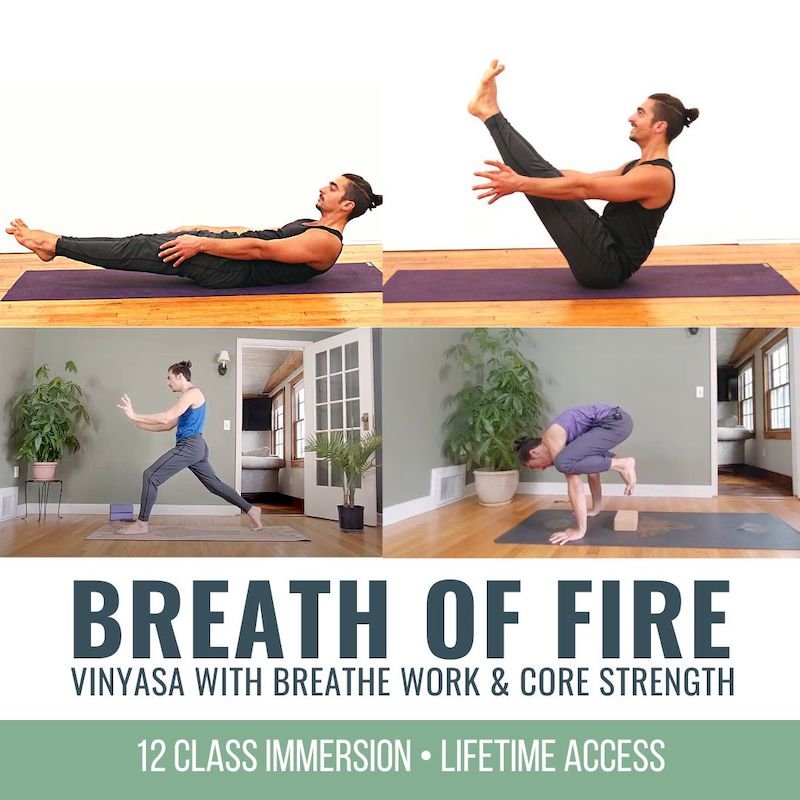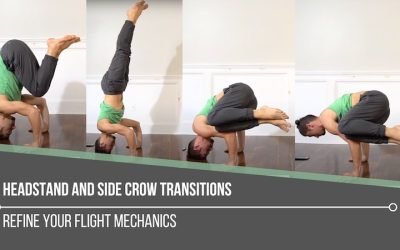Handstand ActionsLEAN, GRIP, PUSHHANDSTAND ACTIONS Handstand isn’t something we conquer in a single class, it’s a layered process that demands repetition and refinement. There are certain key handstand actions that are non-negotiable: lifting the shoulders up to the...
Strengthen Your Diaphragm
Strengthen Your Diaphragm
Resistance-Band Breath Technique
breathe
STRENGTHEN YOUR DIAPHRAGM
Strengthening your diaphragm. Is that a thing? It absolutely is, just like any other muscle you develop and strengthen in your body. The diaphragm is arguably one of the most important because it is one of the main muscles that helps you breathe. How do you strengthen the diaphragm? One way to work with this muscle is to engage it. This happens naturally when we inhale, of course, because of the natural movement that occurs: The diaphragm moves downward towards the lower vertebrae in order to create space, while the vacuum of pressure pulls air into the lungs. What Matt demonstrates today is not this natural engagement but instead a sustained engagement in order to work on the endurance and strengthening of the diaphragm.
BREATH OF FIRE
- Moderate Vinyasa-style classes
- Core strengthening & integration
- Master your breath with pranayama practices
- Access your core in arm balances, heart openers, twists, forward folds, inversions, and more
- Learn where and how to breathe in challenging postures
- Each class will include one pranayama (breathwork practice) and several core strengtheners
- Access your core muscles: deep, superficial, anterior, posterior, and lateral
- 12 Classes: All levels appropriate
- Lifetime unlimited access to all
- Attend the livestream OR practice the replays any time that’s convenient for you
$148.00
BHASTRIKA PRANAYAMA
Maintaining the sustained engagement of the diaphragm may sound reasonably simple; however, it may be quite uncomfortable if it’s something you’ve never practiced before. In order to train your body and nervous system for the mechanics of each movement and/or drill ahead, Matt prepares you in his current immersion, Breath of Fire, with a breath technique at the beginning of each class.
Bhastrika pranayama is the ideal pairing for the resistance-band technique that Matt demonstrates in today’s video. Bhastrika pranayama is referred to as Breath of Fire, or Bellows Breath. This breath technique involves emphasis and effort on both the inhale and the exhale. Practicing a few rounds with multiple repetitions gets the brain on board, particularly with the action of the inhale. The action of pushing your belly out on the inhale provides more force, focus, and movement of your diaphragm.
WATCH THE VIDEO
STRENGTHEN YOUR DIAPHRAGM: RESISTANCE BAND BREATH TECHNIQUE
HOW DOES BHASTRIKA COMPARE TO KAPALABHATI?
So, why not Kapalabhati pranayama as preparation for the resistance-band technique Matt explores today? It’s because the difference between Bhastrika and Kapalabhati is where the emphasis is placed in the breath. With Bhastrika, the inhale is quite active, whereas with Kapalabhati, the inhale is passive. This creates more emphasis on the exhale and the movement “in and up” of the transversus abdominis. Visually, the two breathing practices may appear very similar, but the sensation and experience are quite different.
Matt advises you to build gradually. For example, you may start with 15 repetitions and then gradually move your way up to 30. The goal is to gradually become more familiar with pushing your belly out, thus moving the diaphragm down in order to train it for strength. What becomes apparent is that you actually affect more than the diaphragm. You tap into connections with other core muscles.
200 HOUR ONLINE TEACHER TRAINING
GET CERTIFIED & DEEPEN YOUR YOGA PRACTICE
- Deepen your yoga practice
- Build confidence speaking in front of groups in person and online
- Learn foundational class structures and templates
- Learn techniques for a wide range of yoga postures
- Get certified and highly qualified to teach yoga
- Yoga Alliance Globally Recognized Certification Program
MORE THAN YOUR ABDOMINALS
Your core is much more than just your abdominal muscles. The exercise Matt breaks down today requires quite a bit of work from your iliopsoas muscles, which are also part of your core. Creating strength in the diaphragm includes exploring sustained engagement outside of isolation, and activating the iliopsoas in conjunction with the diaphragm means that you are incorporating more of your core muscles and therefore creating more integrity within the whole “core system.” The act of pushing your belly down and out on both the inhale and the exhale also supports the connection with the core muscles in your back body (e.g., erector spinae and multifidus).
300 HOUR ONLINE TEACHER TRAINING
GET 500 HOUR CERTIFIED AS A MASTER TEACHER
Master your skill set as a teacher through refined techniques, anatomy, biomechanics, sequencing, philosophy, meditation techniques, theming, yoga business, and much more!
- Get 500 hour certified
- Learn anatomy, biomechanics, asana techniques
- Expand your teaching skills
- Masterful sequencing and verbal delivery
- Learn meditation and breathwork techniques
- Transformative tools: theming, dharma talks, satsang
RESISTANCE-BAND BREATH TECHNIQUE
First of all, if you’re familiar with the core exercise called Dead Bug, you’ll be familiar with the basic mechanics of this exercise. What may be new for you is the consistent activation of your diaphragm while executing the core work.
What role does a resistance band play with this breath/core technique? Well, as Matt explains it, the band acts somewhat like the transverse abdominis and is there to entice you to pull your belly in and up. What you will actually do is push your belly down and out, into the band.
This action, in addition to the cross action of pressing your opposite hand into your thigh and the thigh into your hand, is what engages your iliopsoas muscles.
This is much harder than it appears. Of course the level of difficulty is increased due to the balance factor, but it’s really the engagement of your diaphragm that multiplies the sensations in this technique.
Expand on this experience in Matt’s current immersion, Breath Of Fire. Delve into deeper knowledge of your core muscles in order to both breathe and move better.
See you on the mat!
The 200 Hr. Teacher Training: Click Here to See the Next Start Date
The 300 Hr. Advanced Teacher Training: Click Here to See the Next Start Date
Article by Trish Curling
Video Extracted From: Breath Of Fire Immersion
BREATH OF FIRE
- Moderate Vinyasa-style classes
- Core strengthening & integration
- Master your breath with pranayama practices
- Access your core in arm balances, heart openers, twists, forward folds, inversions, and more
- Learn where and how to breathe in challenging postures
- Each class will include one pranayama (breathwork practice) and several core strengtheners
- Access your core muscles: deep, superficial, anterior, posterior, and lateral
- 12 Classes: All levels appropriate
- Lifetime unlimited access to all
- Attend the livestream OR practice the replays any time that’s convenient for you
$148.00
Continue Learning
Handstand Actions
Handstand Mechanics
Handstand MechanicsINVERSIONHANDSTAND MECHANICS Stability, strength, and coordination come together in the pursuit of mastering handstand mechanics. One of the most critical foundations is internal rotation at the hip joints, which can aid with certain entries and...
Stable Sirsasana
Stable SirsasanaHEADSTANDSTABLE SIRSASANA Creating a stable Sirsasana is less about the final pose and more about the mechanics that lead us there. From weight transfer and spinal alignment to hamstring flexibility and shoulder engagement, each layer matters. Unlike...
Explore Hip Rotation
Explore Hip RotationSURYA YANTRASANAEXPLORE HIP ROTATION Hip rotation isn’t just an anatomical concept—it’s an open invitation to become more intimate with our body’s story. In yoga, we often live in lateral (external) rotation, especially in hip-opening postures....
Step Up Your Side Plank
Step Up Your Side PlankVASISTHASANASTEP UP YOUR SIDE PLANK Side Plank might look simple, but true proficiency starts in the details. One of the keys to refining the posture is learning how opposing muscle groups create an isometric contraction—a subtle engagement that...
Headstand and Side Crow Transitions
Headstand and Side Crow TransitionsPARSVA BAKASANAHEADSTAND AND SIDE CROW TRANSITIONS Mastery begins with mechanics, especially when it comes to headstand and side crow transitions. Each posture on its own demands control, coordination, and a deep understanding of...
THE FREE TECHNIQUE PACK
When You Subscribe, You Will Get Instant Access to
- the Technique Pack: 15 yoga pose breakdowns
- exclusive online course discounts
- exclusive blogs and videos











